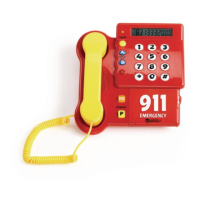911 and Operator
Press 911 on keypad to hear "emergency" message. Dial 0 to hear
"operator's" message.
Speed Dial Buttons (A and B)
Fun speed dial messages help children learn how to use the telephone to
call friends and relatives and to get information. Each speed dial message
ends in a question to encourage language skills. For example, one
message says: "Hello dear. This is Aunt Gladys. My little Fifi just had
puppies! Can you come over and see them?"
*
and
#
Buttons
Press the
*
button to hear ringing. Press the # button to hear busy signal
and to display programmed number.
Teaching Telephone
™
Activities
Calling Home
It is very important that young children know their home telephone
number, including area code. Use the Teaching Telephone to help your
child learn how to call home!
1. Begin with your 7-digit telephone number. Break the telephone number
into two separate pieces: the first three numbers, and the last four
numbers. It is easiest for most children to learn the two "pieces"
separately and then put them together. Write your 7-digit telephone
number on the note pad so your child can see it.
2. Practice saying your 7-digit number aloud with your child. Encourage
him or her to read the telephone number as they say it. After you have
practiced reading and saying the telephone number many times, try
saying it without looking at the written number.
3. Follow the instructions listed under "Programming a Telephone
Number" to program your 7-digit telephone number into the Teaching
Telephone. Then record a message that congratulates your child for
dialing the correct telephone number. Ask your child to pick up
the receiver, listen for a dial tone, and dial his or her home telephone
number into the Teaching Telephone. If he or she dials correctly, he or
she should hear your message! If he or she makes a mistake while
dialing, tell him or her to simply hang up and dial again.
4. Have your child practice dialing the number several times.
5. When your child has mastered the 7-digit telephone number, explain
that if he or she is far away from home, he or she needs to add four
more numbers in front of the home telephone number when he or she
dials. Explain that these additional numbers are called the area code.
6. Reprogram the Teaching Telephone with 1+ area code and then your
home phone number. Repeat steps above to teach your child to dial the
11-digit number.
Emergency Telephone Skills
• Children as young as three should learn how to use the telephone to get
help in case of an emergency. It is important to discuss with your child
emergency situations such as fires, medical emergencies, and stranger
situations that may require him or her to use the telephone to reach
emergency services such as the fire department, police department, or
paramedics.
• Make sure your child understands that the Teaching Telephone is not a
real telephone, and cannot be used in case of an emergency. Explain
which telephones in your home should be used to call for help, so your
child understands the difference between real and toy telephones. On
the Teaching Telephone, dialing 911 will play a pre-recorded voice,
saying: "911. What is the emergency?"
• Following these steps will help you prepare your child for using the
telephone in an emergency situation:
1. Teach your child the emergency telephone numbers he or she needs to
know. In most cities, 911 is the number you dial for any emergency.
Check to see if 911 is used in your town, and inform your child if it is.
Explain that 911 is a short, easy way to call for help using a real
telephone. If 911 is not available in your area, teach your child the
7-digit numbers used for fire, police, and paramedics by programming
the numbers into the Teaching Telephone. Follow the programming
directions in the "Programming a Telephone Number" section to do
this. Post these numbers OR 911 near all telephones in your home for
easy reference. Also post your home address and telephone number, as
well as other important names and telephone numbers.
2. Discuss situations and reasons for calling 911 with your child. Explain
that sometimes it is not necessary to call 911. The following list may
help fuel your discussion.
It's usually good to call 911 when these things happen:
You get lost
Someone gets hurt
Something unusual is burning or producing smoke
Someone is breaking into a home
4
5

